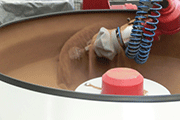E-Archive
Articles
in Vol. 17 - May Issue - Year 2016
Additive Manufacturing

(1)

(2)

(3)

(4)

(5)

(6)

(7)

(8)
Additive manufacturing is opening a new world of opportunities anywhere the requirement of complex geometries and or a low series of parts is required.
The many advantages and horizons opened by this technology are really interesting and, accordingly, a large number of applications is arising here and there.
Nevertheless a common aspect of almost all the components made with additive manufacturing is the surface roughness, which is tremendously high.
How to handle this aspect is a frequent "main problem" coming immediately after the realization of the first component.
Already touching the part with the fingers, it is easy to feel how rough the surface is, but, as soon as the rugosimeter can detect this value in precise terms, the levels of rugosity are much higher than any component coming from machining, higher than parts after even rough grinding and also, sometimes, higher than casted components.
When the component is a full surface, this aspect is already hard to solve.
When the component is like the picture below (2), the problem is also most complex.
How to handle this kind of problem?
The reply is not, of course, only one.
The finishing technology is depending on the material characteristics of the final workpiece, of its surface (full or texturized as a net), of its physical characteristics (hardness, alloy, mechanical resistance), of the final required precision of the geometry, of the number of components to process per batch, on the next process foreseen on the same component, on the need to get a finishing process in open surfaces or inside blind holes, and, last but not least, by budget limits.
Furthermore, prior to expecting an overall surface finishing of the component, it is possible that some areas cannot be considered with the same precision requirements as the rest of the component, but with a higher precision need.
Accordingly, the component could be "roughly finished" first, then machined in the few points where the precision is required, then, if needed, finely finished furthermore.
At Rollwasch Italiana S.p.a. laboratories, several components produced with Additive Manufacturing have been finished with successful technologies.
According to the above criteria, it is, on one hand, very important to improve the additive manufacturing technologies focusing on the above criteria of higher densities.
On the other hand, the finishing technologies must be further specialized in the area of additive manufacturing, being a quite specific technology that needs smart solutions in a short time. (Pic. 3)
Statistically, in almost all the experiences undertaken, the approach, even with different finishing techniques, is performed in two steps:
Preliminary rough attenuation of the rugosity
Finest reduction of the surface roughness
Finest is the final rugosity required, higher should be the density of the material to be finished.
In other words, when the additive manufacturing builds up a structure with too many empty spaces, bubbles of air and/or porosity, the surface finishing, even done with good criteria, will be influenced in the final rugosity detection by too many negative points that of course cannot be "filled up" during the finishing operations.
Whenever the additive manufacturing should build up a structure with much less empty space, and higher density, the final finishing will improved results and meet the finest RA values.
In cooperation with Cetim - Saint Etienne – France (http://www.cetim.fr/en), Rollwasch revealed a finishing demonstration of a prototype of a urbine blade made in laser cast between 2013 and 2014: (Pic. 4, 5)
As evidenced by the pictures, the surface was extremely rough on both sides, convex and concave.
The approach to this kind of component has been to foresee a preliminary regularization of the surface by means of a six-axis controlled-robot grinding, combined to a seventh virtual axis determined by the pressure control of the grinding wheels (belt-grinding machine, with special Siemens-S7 plc-controlled pressure parameter, interactive with the grinding program scheduled on the system plc). (Pic. 6)
After the surface preparation is performed in this way, a further refining of the surface rugosity has been achieved by means of wave finishing - the rugosity values meet the requirements without alteration of the expected final geometry. (Pic. 7, 8)
In fact, the "Wave Finishing" process is made to assure the exposition of each point of the surface, to the finishing wave made of very fine media granulates, according to a scheduled finishing time, thus enabling a different effect in every different point such as trailing edge, leading edge, convex and concave surfaces.
For Information:
Rollwasch® Italiana S.p.a.
Via San Carlo, 21
20847 Albiate (MB), Italia
Tel. +39.0362.930334
Fax +39.0362.931440
E-mail: info@rollwasch.it
www.rollwasch.it



























